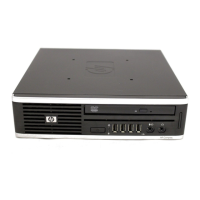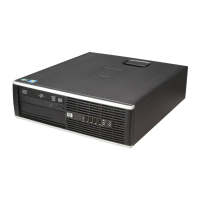ROM BIOS Information
Key features of the HP BIOS include:
Deployment and manageability – HP BIOS provides several technologies that help integrate the HP Business desktop
computer into the enterprise, such as PXE, remote configuration, remote control, and F10 Setup support for 12
languages.
Stability – HP BIOS supports the HP stable product roadmap by releasing only critical BIOS changes to the factory
and advanced change notification.
Security – HP BIOS offers a robust and flexible set of security features to help the system administrator secure their
systems from removal of sensitive data, and help prevent access by unauthorized users. Ability to disable USB ports.
Tracking and tracing capabilities in case of theft available in select countries (subscription sold separately).
Thermal and power management – The HP BIOS provides and enables thermal and power management technologies
to assist in operating the HP Business Desktop computer in any enterprise environment.
Serviceability – HP BIOS provides diagnostic and detailed service information.
Upgrades and recovery – HP BIOS provides numerous ways to upgrade HP Business Desktop computers, including
BIOS updates from within DOS (Flashlite), BIOS updates from within Windows (HPQFlash, SSM), HP Client Manager,
and fail-safe recovery. In addition, the HP Business Desktop BIOS Utilities tool enables replicated BIOS setup
throughout the Enterprise; it is available from within the BIOS software and from the support website.
Additional HP BIOS Features
Administrator password – Also known as the setup password, this helps prevent unauthorized changes to the system
configuration. If the administrator password is not known, the BIOS version cannot be changed and changes cannot
be made to BIOS settings using F10 setup or under the OS.
Advanced Configuration and Power Interface (ACPI) – Represents a significant innovation in power and configuration
management, allowing operating systems and applications to manage power based on activity and usage. Provides
power conservation features under Windows XP.
Mute internal speaker
Disable USB ports
Other Features
Description
ACPI-Ready Hardware
Advanced Configuration and Power Management Interface (ACPI).
Allows the system to wake from a low power mode.
Controls system power consumption, making it possible to place individual
cards and peripherals in a low-power or powered-off state without affecting
other elements of the system.
SMBIOS Ver. 2.6
System Management BIOS, previously known as DMI BIOS, for system
management information
Dual-State Power Button
Power button acts as both an on/off button and suspend-to-sleep button
QuickSpecs
HP Compaq 6005 Pro Business PC
Technical Specifications
DA - 13412 Worldwide QuickSpecs — Version 6 — 10/14/2009
Page 16

